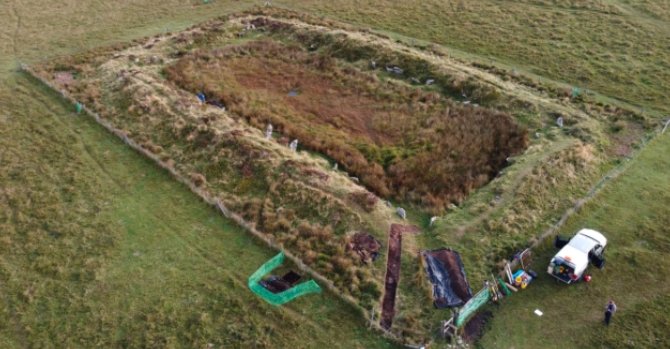A stunning new discovery in Cornwall, England, has rewritten history, revealing that the famed King Arthur’s Hall on Bodmin Moor is far older than previously believed. For centuries, the stone structure was thought to date back to medieval times, with some even speculating it was an animal pen. However, recent archaeological excavations have uncovered evidence that the site actually dates to the Neolithic era, around 3000 B.C.E. This revelation could drastically change our understanding of prehistoric Britain.
A Monumental Find
King Arthur’s Hall, a mysterious stone structure located on the windswept Bodmin Moor, has long been shrouded in mystery. Despite its name, which has been associated with the legendary King Arthur for centuries, the site had little to do with the famous medieval king. It is, however, one of Cornwall’s most enigmatic landmarks, with its 56 standing stones, some towering up to six feet, lining the edges of a large rectangular enclosure. Local folklore and amateur historians had speculated about its true origins, but it wasn’t until recent excavations that the full scope of its history was revealed.
The excavation was carried out by Cornwall National Landscape in collaboration with Historic England, and it uncovered far more than expected. What researchers once thought was a medieval cattle pen is now understood to be a Neolithic monument, possibly built as far back as 3000 B.C.E. “The new findings are a major revelation,” said lead archaeologist James Gossip, who worked on the project. “This could completely transform our understanding of early Neolithic communities and their building practices.”

Rewriting History: From Medieval to Prehistoric
For generations, King Arthur’s Hall was thought to be a medieval construction, likely built for agricultural purposes. The site’s association with King Arthur has long been a part of local legend, but archaeologists had dismissed these claims, attributing the site to a much later period in history. However, as interest in the structure grew, local enthusiasts and amateur archaeologists began to question these assumptions.
In 2020, Cornwall National Landscape decided to fund an excavation of the site, enlisting the help of professional archaeologists and experts from Historic England. The team used cutting-edge techniques like optically stimulated luminescence (OSL) to date the soil under the structure, a method that allows researchers to determine when the soil last saw sunlight. The results were groundbreaking—King Arthur’s Hall was found to have been constructed around 3000 B.C.E., more than 4,000 years earlier than previously thought.
The discovery is a critical piece in understanding the prehistoric communities that inhabited Britain long before the rise of the medieval kingdoms. “They’ve dug down through the earth of Bodmin Moor to the loose granite on the surface, and they piled it up to make these ramparts,” explained Gossip. “What they did in our favor was they buried these very ancient soils below them, which we could target for OSL.”
What Was King Arthur’s Hall Really For?
While its exact purpose remains a subject of debate, the true nature of King Arthur’s Hall is slowly being pieced together by experts. The structure consists of a banked enclosure measuring around 160 feet in length and 70 feet in width, surrounded by large standing stones. Some experts believe it may have been a ritual site, while others speculate it could have had ceremonial or social functions for Neolithic communities.
The standing stones, arranged in a precise manner, suggest that the site was carefully constructed with a specific purpose in mind. Some archaeologists have likened it to other prehistoric sites across Britain, such as Stonehenge, which also features large stone structures and is believed to have had both ritual and astronomical significance.
Moreover, the proximity of King Arthur’s Hall to other ancient Neolithic sites, including burial mounds and ceremonial structures, hints that it may have played a role in a larger network of sacred places across Cornwall. Although its precise function remains unclear, researchers believe the site was of great importance to the people who built it.
The Link to King Arthur: A Matter of Legend
The connection between King Arthur’s Hall and the legendary King Arthur is a matter of folklore rather than historical fact. The site’s name has been in use since at least 1583, but it is likely that the association with the medieval king was a later invention, made to capitalize on the growing Arthurian legend.
The stories of King Arthur, his knights, and the legendary battles fought during the medieval period have captivated generations, and the name “King Arthur’s Hall” may have simply been a convenient label for a mysterious structure that seemed to fit the narrative of the Arthurian myths. However, the name’s persistence speaks to the lasting power of these legends in shaping how we view ancient sites.
Researchers have long debunked the idea that King Arthur’s Hall was ever connected to the real-life figure of Arthur, whose existence is still debated by historians. Nevertheless, the name has become part of the site’s cultural identity, contributing to its mystique.
A New Chapter in Cornwall’s Prehistoric Past
The discovery of King Arthur’s Hall’s true age is just the latest chapter in Cornwall’s rich prehistoric history. Cornwall is home to many ancient sites, from the Bronze Age burial mounds at Carn Euny to the Neolithic chambered tombs found in the area. Each new discovery adds a layer of understanding to the complex story of early human life in Britain.
For now, the revelation that King Arthur’s Hall dates back to 3000 B.C.E. is a reminder of how much we still have to learn about our ancient past. As researchers continue to study the site, it is likely that even more secrets about its purpose and significance will emerge, further enriching our understanding of prehistoric life in Britain.













